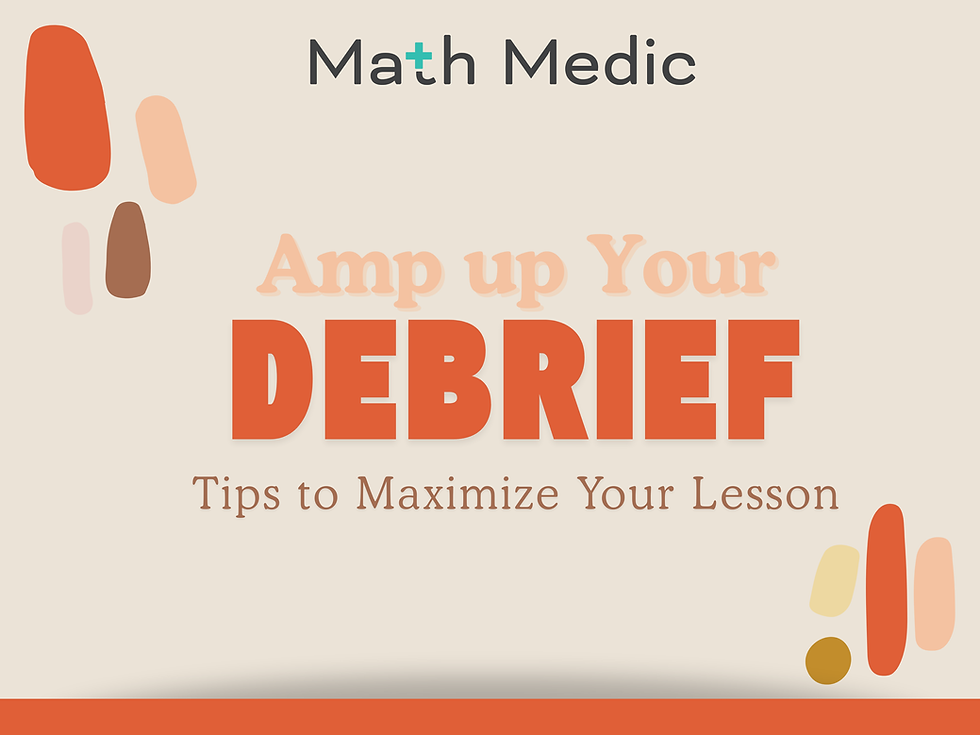What We're Getting Wrong About Math Class
- Sarah Stecher

- Oct 13, 2023
- 4 min read
Updated: Feb 16
Although we’ve made some progress in math education in the last 20 years, I’m sometimes shocked by how much hasn’t changed. How deeply entrenched certain ideas are, and not usually the ones that are most conducive to student learning. One of those ideas is our tendency to think of classroom learning as a one-way street. Information gets passed from the teacher to the students. We task students with developing a new way of thinking that aligns with expertise in the mathematical community and discipline. Even when this happens through discovery-based approaches rather than direct instruction, there is still the underlying assumption that students must repair, formalize, or even discard their informal and intuitive strategies to arrive at the content being taught. Students’ ideas, intuitions, perspectives, hypotheses, estimations and available language may be the starting point but they are hardly ever the focus. They are seen as the humble raw ingredients, but rarely as the delicious cake.
Our goal should be to illuminate and develop students’ thinking (and by this I mean make it sturdier, broader, and more connected), not replace it with something entirely different.
Investigating and developing, not replacing student thinking
Student thinking is not just the vehicle to formal, rigorous, capital M Math, it is the actual object, telos, goal of our instruction.
Students think in interesting ways. They are making sense of their world. This is not a skill we’re trying to fabricate out of thin air. The problem is that we usually don’t pay enough attention to the ways they’re already doing this and opt instead to train them in the way mathematical experts make sense of their world. We say: “Here is what the experts think. Are you thinking like this yet?”*
Now, don’t get me wrong. Expert thinking is expert for a reason. There is value in it. Math class is not just engage-with-your-own-thoughts-and-stay-there time. But I think we would do well to spend more time discussing how that expert knowledge came to be. What problem did it solve? What tedious task did it make surprisingly simple? What complicated and disheveled ideas did it make more clear or sophisticated? And students need to be the ones making these discoveries!
But that is not enough. Once they’ve “discovered” it, we tend to quickly turn to fluency and mastery rather than continuing the thinking process. We tend to give up on sense making after students have gotten their initial dose of exploration.
“You did good thinking and reasoning today, but what I really need from you is to understand that in the equation y=mx+b, b represents the starting value and m represents the slope. Please know this every single time I present you with a line, whether in context or in the abstract, from a graph, table, or equation. Don’t question it. Just know it.”
Why we bypass student thinking
Why do we so often find ourselves on this mad rush past student reasoning to formal Content and Standards? (Trust me, I am NOT immune.) This is a question I’m still wrestling with, but my hypothesis is this: we are still too focused on students getting correct answers. I imagine the line of thinking goes like this (again, working theory):

We use students' right answers as validation, as if they told us everything we needed to know about what students know, who they are as learners, and who we are. Ask yourself this: are you more happy when a student gets an A on a test or when they presented a really interesting strategy in class? We may never say out loud that our focus is on answer-getting, and yet almost all our practices lead to this conclusion.
Perhaps this disconnect between our philosophy of math teaching and practice of math teaching is why math class is still feared and hated by students and adults alike. They fear it because at some point in their math journey they have been made to feel dumb, and they hate it because it feels arbitrary and irrelevant and needlessly particular and endlessly exacting. But note that I am talking about math class, not math. Our goal is not to try to make math relevant and exciting. Our goal should be to make math class reflect the joy and possibility of math, which is entirely based on ideas and reasoning.
In his substack newsletter MathWorlds, Dan Meyer recently summarized this much better than I ever could when he wrote about the biggest issue with math class today.
“The main problem is not that kids find math class useless and irrelevant.
The main problem is that math class finds kids useless and irrelevant.”
(If you’re not already subscribed to MathWorlds, do it. Reading his weekly posts is often the highlight of my professional week. He offers thoughtful, provocative new ideas in math education with a particular focus on centering students and their thinking. It is a delight.)
So what are we getting wrong about math education?
I think it's focusing too much on content and not enough on students. Recognizing and leveraging the unique traits and talents of all the individuals in our classroom can only be done in an environment that prioritizes inviting, exploring, and building on students’ ideas.
_________
*I stole the language of this quote from Dan Meyer, it’s not my own. He really does an extraordinary job of communicating his observations in a simple and illuminating way!



